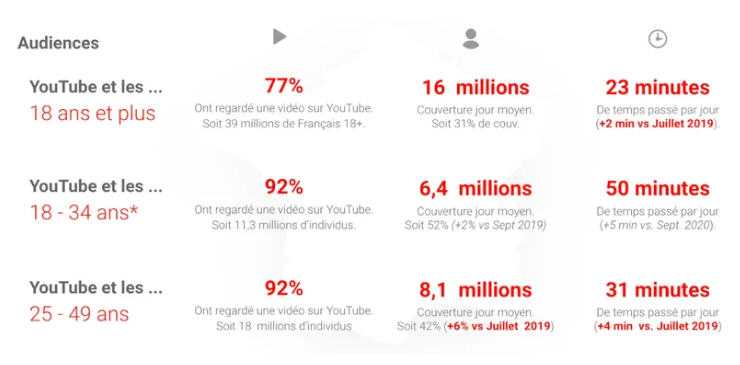Video streaming emits 300 Mt of CO2 per year, or 1% of global carbon emissions. This is equivalent to half the impact of civil air traffic, but the proportion is growing. YouTube alone is responsible for about 20% of these emissions.
The eco-design of a site is measured by different indices (Ecoindex, Kastor Green, GT Metrix, Website Carbon Calculator…) which all have some bias but have the merit of giving a direction for the development of pages that are more sober in terms of images and various queries. Except that there is a simple way to hide the biggest carbon impact of the site from them: link to a YouTube page.
Why not evaluate the impact of a site’s YouTube page at the same time as the site itself? As a matter of fact, it is the site’s editor who is responsible for the carbon emissions of its videos – and the associated playback – on the social network.
The Temesis agency has shown that YouTube is not a model of eco-design or digital sobriety, and this is no surprise.
Even the tools that allow an Internet user to calculate the carbon impact of his or her Internet use do not take into account video viewing. According to Médiamétrie, the average time spent on YouTube (in 2020) is 23 minutes per day for the over 18s and 31 minutes per day for the 25-49s!

For example, let’s simulate an intensive use of the internet with the INR calculator, for a person from 25 to 49 years old:
- 35 h per week of web browsing represent = 16,10 Kg eCO2 per year
- 10 h weekly of videoconferences with the camera on = 11,48 Kg eCO2 yearly
- 20 daily e-mails without attachment and 5 with attachment = 58,65 Kg eq.CO2 annual
- Total = 86,23 Kg eq.CO2 yearly
In comparison, 0,5 h of video / day x 5 days x 52 weeks = 416 Kg eq.CO2 annual
This is almost 5 times more than all other digital uses and it is not counted!
If it is urgent to decarbonize its uses, shouldn’t we start with video instead of ignoring it?
We can always discuss measures and absolute values but it is obvious that it is more efficient to practice what we call responsible streaming than to lighten a page or to delete emails.
Is a site really eco-designed when it hosts its videos on a social network whose impact is not measured? It’s an optical illusion, but it works.
When Visionarymarketing praises the ecoindex of the Grenoble site and contrasts it with that of the Île de France Region, both sites – communities concerned by the REEN law – have the same approach to their videos.
A social network is used to create buzz, to generate interactions, to federate a community of subscribers, to create virality. Is this what companies and communities are looking for when they upload their videos, requiring their visitors to consent to the sharing of their personal information?
Or it’s got to be the cost.

Hosting videos on a social network is free and unlimited, so you don’t have to worry about sobriety. For what savings?
In most cases, professional – and eco-responsible – video hosting will only cost a few hundred euros per year. Much less than the cost of an eco-responsible video production or an eco-designed website…
A local authority, a ministry or an industrial group wouldn’t go and create a free site at Wix, so it’s not just a question of money.
So if you are aware of Digital Responsibility (and GDPR), do you think that a social network is the appropriate solution for hosting your videos?
ADEME and ARCEP have just published a study that shows that when it comes to the environmental impact of digital technology, not acting right away is no longer an option. However, we often hear spokespersons of responsible digital encourage procrastination and say that not all actions are useful.
The study can be read here. It highlights the fact that the goal of digital carbon neutrality in 2050 will be completely unattainable if “digital sobriety” policies are not implemented right away. Only one scenario allows for no more GHG emissions in 2050 than in 2020. It would be achieved “mainly through frugality through constraint and sobriety”.
Frédéric Bordage, an expert in green IT, gave his analysis of this study: “It emerges that the “business as usual” approach is untenable and that the most virtuous scenario would require clearly circumscribing the place of digital technology in the activities of the whole of society.”
What is the state doing about this? In a Circular from the Prime Minister dated February 25, 2020, the State commits to 20 measures for eco-responsible Public Services. The twentieth concerns digital: “the State is developing a strategy to reduce the carbon footprint of public digital, which will include in particular an approach to raise awareness of digital eco-actions among agents and the purchase of reconditioned equipment or consumables.”
Let’s hope that government services will be exemplary and reasonable if they come to consider video as an integral part of their digital footprint.
Mediatech / Streamlike and Ouest Médias will be speaking together at a conference on “eco-design of communication actions” at the Congrès de la Communication Responsable, on Friday June 16th at 9:30 am at the Beffroi de Montrouge, in Montrouge.
We invite you to register now by clicking here and to discover the complete program.
